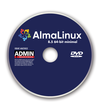News for Admins
Tech News
AlmaLinux 8.5 Now Available For PowerPC Hardware
Both PowerPC and IBM Power Systems hardware can now enjoy that fresh feeling brought about by the drop-in CentOS replacement, AlmaLinux. This support for 64-bit PowerPC architecture includes the release of binary and source RPMs, container images, and cloud images. According to Jack Aboutboul, community manager for AlmaLinux, "We're looking beyond just the base operating system, in providing containers and cloud images as well, since those are of extreme importance and utility to our users." Aboutboul continues, "We're currently working to deliver support for S/390 as well for eventual full parity with RHEL. The community shouldn't settle for anything less."
This is a fully stable release (as the beta was made available back in January), and there are currently three different versions available:
- AlmaLinux-8.5-ppc64le-boot.iso – a single network installation CD image that downloads packages over the Internet
- AlmaLinux-8.5-ppc64le-minimal.iso – a minimal self-containing DVD image that makes possible offline installation
- AlmaLinux-8.5-ppc64le-dvd.iso – a full installation DVD image containing almost all AlmaLinux packages
To download the version you want, open a terminal window and issue the command wget https://repo.almalinux.org/almalinux/8.5/isos/ppc64le/VERSION where VERSION is the name of your desired release from the list above (or download the versions directly from https://repo.almalinux.org/almalinux/8.5/isos/ppc64le/).
Find out more about this new AlmaLinux release in the release notes (
...Buy this article as PDF
(incl. VAT)
Buy ADMIN Magazine
Subscribe to our ADMIN Newsletters
Subscribe to our Linux Newsletters
Find Linux and Open Source Jobs
Most Popular
Support Our Work
ADMIN content is made possible with support from readers like you. Please consider contributing when you've found an article to be beneficial.




